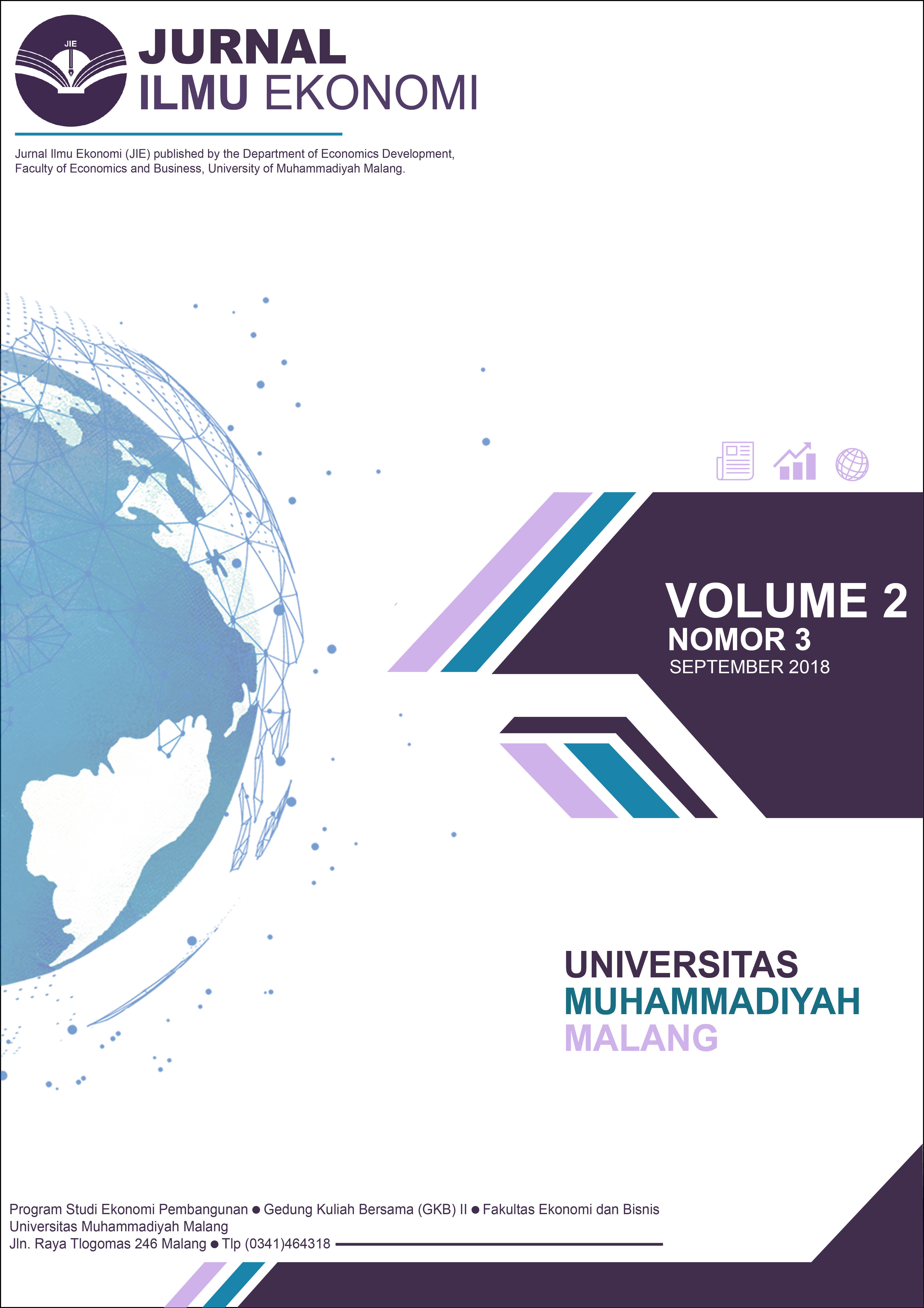IDENTIFIKASI STRUKTUR PASAR PADA INDUSTRI KERAMIK DI KOTA MALANG
DOI:
https://doi.org/10.22219/jie.v2i3.7099Abstract
This reasearch aimed to determine the condition of ceramic industry in Malang City and calculate the market structure of ceramic industry in detail by using market structure approach. This approach can be calculated by using market share, Hirchman Herfindahl Index (IHH), and CR4 (Concentration Ratio for Biggest Four). This study used quantitative descriptive analysis with the markets as the object of study. The result of the study showed that the market had the largest concentration ratio with 12.12% that led to the market structure of competition. The value for IHH was 0.05 that led to the perfect competition market because its value was between zero and one. Then, the value of CR4 was 0.36 that led to perfect competition market structure because its value was < 20%. It can be concluded that the degree of ceramic industry business in Malang City went to perfect competition market structure.
Keywords: Ceramic Industry, Market Structure, Market Concentration
Downloads
References
DAFTAR PUSTAKA
Arifin, Z. (2006). Konsentrasi Spasial Industri Manufaktur Berbasis Perikanan di Jawa Timur (Studi Kasus Industri Besar dan Sedang). Humanity, 1(2), 142–151.
Arifin, Z. (2011). Analisis Spasial Industri Kecil dan Menengah di Propinsi Nusa Tenggara Timur. Jurnal Ekonomi Pembangunan UMM, 9, 157–173.
Azizah. (2013). Konsep Pengembangan Pendekatan Struktur Dalam Perjanjian Penetapan Harga Pada Putusan KPPU. Hukum Dan Pembangunan.
Baladina, N. (2012). Analisis Struktur, Perilaku, dan Penampilan Pasar Wortel di Sub Terminal Agrobisnis (STA) Mantung (Kasus pada Sentra Produksi Wortel di Desa Tawangsari, Kecamatan Pujon, Kabupaten Malang). Agrise, XII(2), 1412–1425.
Budi, S., & Yuli, C. (1993). TERHADAP KOMPETENSI USAHA ( Studi pada Pengusaha Makanan dan Minuman Skala Kecil dan Menengah di Kabupaten Malang dan, 106–116.
Jaya, W. K. (2001). Ekonomi Industri (Edisi 2). Yogyakarta: BPFE.
Kusuma, H. (2016). Flypaper Effect: Fiscal Illusion and Bureaucratic Model. Jurnal Ekonomi dan Studi Pembangunan, 9(1), 28-40.
Nuraini, I. (2017). Kualitas Pertumbuhan Ekonomi Daerah Kabupaten/Kota Di Jawa Timur. Jurnal Ekonomi Pembangunan, 15.
Rizkyanti, A. (2010). Analisis Struktur Pasar Industri Karet Dan Barang Karet Periode Tahun 2009. Media Ekonomi, 18(2).
Setyowati, E., R. Damayanti, Subagyo, R. Badrudin, S.K, Algifari, H. Subiyakto, S. Fatmawati, dan A. P. (2003). Ekonomi Mikro (Pengantar). Yogyakarta: Sekolah Tinggi Ekonomi YKPN.
Sukirno, S. (2010). Mikro Ekonomi Teori Pengantar. Jakarta: Kharisma Putra Utama Offset.
Widyasari, W. W. (2013). Identifikasi Struktur Pasar dan Implikasinya Terhadap Pembentukan Harga (Studi Kasus Pada Sentra Indstri Keripik Tempe Sanan Malang).
Wika, M. R. (2016). Identifikasi Struktur Pasar Pada Industri Sepatu di Kecamatan Sooko Kabupaten Mojokerto. Universitas Muhammadiyah Malang.
Yuli, S. B. C. (2015). Optimalisasi Peran Wakaf dalam Pemberdayaan UMKM. Ekonomika-Bisnis, 6(1), 1–16.
Downloads
How to Cite
Issue
Section
License
Authors who publish with this journal agree to the following terms:
- For all articles published in the JIE (Jurnal Ilmu Ekonomi), copyright is retained by the authors. Authors give permission to the publisher to announce the work with conditions. When the manuscript is accepted for publication, the authors agree to the automatic transfer of non-exclusive publishing rights to the publisher.
- Authors retain copyright and grant the journal right of first publication with the work simultaneously licensed under a Creative Commons Attribution-NonCommercial-ShareAlike 4.0 International License that allows others to share the work with an acknowledgement of the work's authorship and initial publication in this journal.
- Authors are able to enter into separate, additional contractual arrangements for the non-exclusive distribution of the journal's published version of the work (e.g., post it to an institutional repository or publish it in a book), with an acknowledgement of its initial publication in this journal.
- Authors are permitted and encouraged to post their work online (e.g., in institutional repositories or on their website) prior to and during the submission process, as it can lead to productive exchanges, as well as earlier and greater citation of published work (See The Effect of Open Access).
This is an open access article and licensed under a Creative Commons Attribution-NonCommercial-ShareAlike 4.0 International License








